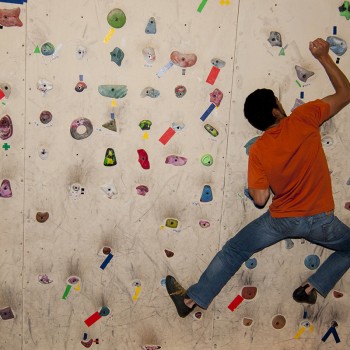ISSUE 66
EDITORIAL BY William Wroblewski
I can’t count how many times I’ve seen it. Or maybe a better word is experience it. Whether bouncing in the crowded seats of a late bus from the altiplano or in the back of a taxi on my way home from an early-morning flight that just landed in El Alto, pre-dawn is the prime time to arrive in La Paz.
In those early-morning hours, there is a black blanket over the valley, hiding Illimani behind its thick curtain. You want to think the city is sleeping, but continued traffic and city sounds tell your hazy mind otherwise. But what gets you is the golden aura of La Paz, the orange, sodium glow that covers the valley in its unique nocturnal hue. The colour is a reminder of the clay bricks that make up the buildings of this city in daylight, but at night the colour has a different, soothing energy. As you approach the ledge of El Alto to begin the winding plunge down into the city’s depths, the lights of El Prado call you down, as the steep slope of Villa Fatima watches from across the valley. Down below to the right, you can make out the similar glimmer from Obrajes and beyond, Zona Sur giving off its own particular colour.
In these moments, no matter how tired I am, how dirty, how uncomfortable, I open my eyes wide to take in the fiery colour of nighttime La Paz.
In this issue of Bolivian Express, we were inspired by these breathtaking moments, which so many of us have experienced living and working here. In day and night, colour takes on special meanings in Bolivia. From the grand swaths of purity in Sucre, Bolivia’s White City, to the rainbows of colors on towering murals breaking the greys and browns in the far reaches of El Alto, colours here continuously surprise. We see them in the blackened fingers and dark clothing of La Paz’s masked lustrabotas, and in the painted faces of its all-too-lovable clowns. And perhaps most notably, the artisans of Bolivia deploy colors to imbue specific meanings in their works, from elaborate, handmade textiles to ostentatious masks and costumes used in traditional dance. And with all the activity throughout the country, from the millions of people here living lives and changing its landscapes to the swaths of tourists visiting its incredible sites year after year, it is people who certainly bring the most colour to Bolivia.
My frequent nighttime rides down into La Paz will always be my strongest association with colour in Bolivia, but this country’s many shades and hues continue to enrich life here. Wherever one wanders, the colours are the first details to note. They contain secrets that can unlock so much of the mystery here, waiting to be understood. But for me, whether I have been gone for two days or two years, that hazy golden ride down the ridge from El Alto to La Paz conjures wonderful feelings inside me. And it reminds me of why I call this place home.
ARTICLES FROM THIS ISSUE

Climbing the rocks of Bolivia
24 Oct, 2016 | Jet De Kort
Photo: William Wroblewski Indoor climbing in the cityHidden in the Sopocachi neighbourhood of La Paz you will find La Cueva Boulder Gym. From the outside, the building looks like any ordinary home, bu...

Reading aguayos
24 Oct, 2016 | Jet De Kort
Photos: Iván Rodríguez Petkovic .Camijeta image Courtesy of MusefDecoding the myths of local communitiesWalking down the crowded streets of Mercado Rodriguez, surrounded by vendors selling odds and en...

Indigenous Justice
24 Oct, 2016 | Alexis Galanis
Photo: Alexis GalanisThe Struggles of Recognizing Legal Pluralism in BoliviaBlaring trumpets and crashing drums reverberate through the white walls of Sucre. On Calle Dalence, hundreds of people, ador...

Drifting through the White City
24 Oct, 2016 | Alexis Galanis
Photo: Alexis GalanisThe stories that lie behind the walls of SucreThe city is known by many names: Charcas, La Plata, Sucre. The uniform whiteness of its walls covers up its seismic historical shifts...

Colours Among the Desolate Beauty of the Altiplano
24 Oct, 2016 | Alexis Galanis
Photo: Alexis GalanisCelebrated Artist Mamani Mamani’s Towering MuralsAs you drive through El Alto to zona Mercedario, the landscape becomes stark, and the hectic hubbub of La Ceja softens to silent d...

The man behind the masks
24 Oct, 2016 | Ellen Weaver
Illustration: Alexandra MeléanSaturnino Ibañez and the face of Bolivian folkloreCalle Los Andes is a hidden gem of La Paz. Located just off Avenida Buenos Aires, this colourful incline will take you o...

Through the Eyes of Outsiders
24 Oct, 2016 | Toby Clyde
The Travellers Passing Through Bolivia and What They SeeThere are always people passing through here. Travellers trickle down through the Peruvian mountains, backpack up from Argentina, or emerge from...

I Can’t Feel My Face When I’m With You
24 Oct, 2016 | Izabela Wlodarczyk
Photo: William WroblewskiA One-Sided Love Affair That Was Never Meant to LastI cannot really explain how this love came to be. What I can tell you is the story of how we met and let you decide it for...

Working in Secret
24 Oct, 2016 | Melody Chan
Photos: Melody ChanThe Shoe-Shine Boys of La Paz.In bright, crowded streets, La Paz’s lustrabotas wear dark clothes to blend in. It’s much too sunny for heavy black masks and jackets, but they choose...

Lake Titicaca
24 Oct, 2016 | Jet De Kort
Photo: Alejandro Loayza GrisiA Changing LandscapeMaking my way down to Copacabana by bus, leaving behind the crowded streets of La Paz, I see the landscape changing. From an urban jungle of diesel-spe...








